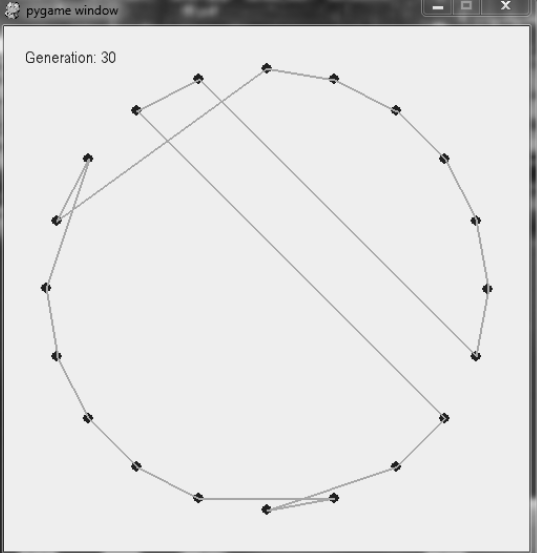本文改编自Mat Buckland的游戏开发中的人工智能技术中的Chapter 4 解决TSP问题(旅行商问题),C++代码重新用python来实现(本文所有遗传算法相关代码均改编值Mat的C++代码,如有雷同,纯属巧合)。
TSP问题(Travelling Salesman Problem)又译为旅行推销员问题、货郎担问题,是数学领域中著名问题之一。假设有一个旅行商人要拜访n个城市,他必须选择所要走的路径,路径的限制是每个城市只能拜访一次,而且最后要回到原来出发的城市。路径的选择目标是要求得的路径路程为所有路径之中的最小值。(从百度拷贝而来)
Mat Buckland选择了围成一圈的城市来进行求解,这样就可以很直观的观察到我们求解的结果是否是所有路径中的最小值,最终结果如下:

定义城市的位置
城市的定义非常简单,在本例中只需要给出城市在窗口中的x,y坐标即可:
class CoOrd(object):
def __init__(self, a, b):
self._x = a
self._y = b
def X(self):
return self._x
def Y(self):
return self._y定义旅行的地图mapTSP
在定义本算法的地图类时,需要接受3个参数,地图的宽和高,以及城市的数量。在定义了这三个参数之后,我们就可以算出圆形布局的城市在地图上所在的x,y坐标,从而创建出需要旅行的地图:
def __init__(self, mapWidth, mapHeight, numCities):
self._mapWidth = mapWidth
self._mapHeight = mapHeight
self._numCities = numCities
self._BestPossibleRoute = 0
self._CityCoOrds = []
self.CreateCitiesCircular()
self.CalculateBestPossibleRoute()
return
def CreateCitiesCircular(self):
margin = 40 #if you have GUI, this parameter should be set
radius = 0
if self._mapHeight < self._mapWidth:
radius = (self._mapHeight/2) - margin
else:
radius = (self._mapWidth/2) - margin
origin = CoOrd(self._mapWidth/2, self._mapHeight/2)
segmentSize = 2 * math.pi / self._numCities
angle = 0
while angle < (2 * math.pi):
thisCity = CoOrd((radius*math.sin(angle) + origin.X()), (radius * math.cos(angle) + origin.Y()))
self._CityCoOrds.append(thisCity)
angle += segmentSize
return当然,在该类中我们需要提供计算一条旅行路径的长度的接口GetTourLength,可能会有人很奇怪为什么在该类中我们又直接计算出了最佳路径的长度self._BestPossibleRoute,既然已经知道结果,为什么还要通过遗传算法来多此一举?其实在进化算法过程中,大多情况下是不能知道最优结果的,只是预先设定一个target,然后通过进化算法不断的逼近这个target(或者是达到一定进化代数后终止进化,取当前进化过程中的最优值),我们在这里预先计算出已知的最优结果作为target是为了更好的展示算法的效果。
def CalculateA_to_B(self, city1, city2):
#print city1, city2
xDist = city1.X() - city2.X()
yDist = city1.Y() - city2.Y()
return math.sqrt(xDist*xDist + yDist*yDist)
def CalculateBestPossibleRoute(self):
#print "Enter CalculateBestPossibleRoute"
self._BestPossibleRoute = 0
for idx, city in enumerate(self._CityCoOrds[:-1]):
self._BestPossibleRoute += self.CalculateA_to_B(city, self._CityCoOrds[idx+1])
self._BestPossibleRoute += EPSILON
self._BestPossibleRoute += self.CalculateA_to_B(self._CityCoOrds[-1], self._CityCoOrds[0])
return
def BestPossibleRoute(self):
return self._BestPossibleRoute
def GetTourLength(self, route):
#print "Enter GetTourLength", route
TotalDistance = 0
for idx, city in enumerate(route[:-1]):
TotalDistance += self.CalculateA_to_B(self._CityCoOrds[city], self._CityCoOrds[route[idx+1]])
TotalDistance += self.CalculateA_to_B(self._CityCoOrds[route[-1]], self._CityCoOrds[route[0]])
return TotalDistance遗传算法 - Genome
求解该问题的Genome的初始化很简单,即生成一个随机的城市id的序列,按照该序列来进行计算旅行的距离:
class SGenome(object):
def __init__(self, nc):
self._Fitness = 0
self._Cities = self.GrabPermutation(nc)
return
def GrabPermutation(self, limit):
Perm = []
for i in xrange(limit):
NextPossibleNumber = random.randint(0, limit-1)
while NextPossibleNumber in Perm:
NextPossibleNumber = random.randint(0, limit-1)
Perm.append(NextPossibleNumber)
return Perm
def Show(self):
print self._Cities遗传算法 - 算法描述
gaTSP初始化时接收参数为:mutRate-变异概率,crossRate-交叉概率,popSize-种群大小, numCities-旅行城市数目,mapWidth, mapHeight - 旅行的地图的宽和高。
self._FittestGenome 是最佳的旅行路径在种群中的索引。
self._Generation 是遗传算法进化的代数。
self._ShortestRoute 用于保存最短路径。
self._TotalFitness 用于保存总的适应度用于个体选择。
self._Population 保存当前种群。
self._Map 保存的旅行地图。
class gaTSP(object):
def __init__(self, mutRate, crossRate, popSize, numCities, mapWidth, mapHeight):
self._MutationRate = mutRate
self._CrossoverRate = crossRate
self._PopSize = popSize
self._FittestGenome = 0
self._Generation = 0
self._ShortestRoute = 9999999999
self._LongestRoute = 0
self._ChromoLength = numCities
self._Busy = False
self._TotalFitness = 0.0
self._Population = []
self._Map = mapTSP(mapWidth, mapHeight, numCities)
self.CreateStartingPopulation()
return种群初始化很简单,生成popSize大小的SGenome并保存到_Population:
def CreateStartingPopulation(self):
self._Population = []
for i in xrange(self._PopSize):
self._Population.append(SGenome(self._ChromoLength))
self._Generation = 0
self._ShortestRoute = 9999999999
self._FittestGenome = 0
self._Busy = False
return同上文一样,依然选择轮盘赌的方式来挑选个体:
def RouletteWhellSelection(self):
fSlice = random.random() * self._TotalFitness
cfTotal = 0.0
SelectedGenome = 0
for i in xrange(self._PopSize):
cfTotal += self._Population[i]._Fitness
if cfTotal > fSlice:
SelectedGenome = i
break
return self._Population[SelectedGenome]变异算子,因为编码方式与上文不同,故变异算子有所差异,这里采用的变异算子称之为交换变异算子(Exchange Mutation Operator),它再染色体上选择两个基因并将其交换:
5,-3-,2,1,7,-4-,0,6这里我们选中3和4,交换位置后的染色体如下:
5,-4-,2,1,7,-3-,0,6代码实现如下:
def MutateEM(self, chromo):
if random.random() > self._MutationRate:
return chromo
pos1 = random.randint(0, len(chromo)-1)
pos2 = pos1
while pos1 == pos2:
pos2 = random.randint(0, len(chromo)-1)
chromo[pos1], chromo[pos2] = chromo[pos2], chromo[pos1]
return chromo交叉算子,同样因为编码方式与上文不同,交叉算子要比上文的二进制交叉略为复杂,这里采用的交叉算子称为部分映射交叉(Partially-Mapped Crossover)。
假设8个城市的问题已经用整数编码,两个可能的周游路径为:
2,5,0,3,6,1,4,7
3,4,0,7,2,5,1,6随机选择两个交叉点,比如第3个和第6个城市之后:
2,5,0, -X- 3,6,1, -X- 4,7
| | |
3,4,0, -X- 7,2,5, -X- 1,6记录下选中的两个交叉点中的映射关系,也就是(3–7, 6–2, 1–5),然后再将这个映射关系用到这两个周游路径本身,这样就生成了两个新的周游路径:
6,1,0,7,2,5,4,3
7,4,0,3,6,1,5,2代码实现如下:
def CrossoverPMX(self, mum, dad):
if random.random() > self._CrossoverRate or mum == dad:
return mum, dad
baby1 = copy.deepcopy(mum)
baby2 = copy.deepcopy(dad)
beg = random.randint(0, len(mum)-2)
end = random.randint(beg+1, len(mum)-1)
for pos in range(beg, end+1):
gene1 = baby1[pos]
gene2 = baby2[pos]
if gene1 != gene2: #每个数字都是应该不重复的
posGene1 = baby1.index(gene1)
posGene2 = baby1.index(gene2)
baby1[posGene1], baby1[posGene2] = baby1[posGene2], baby1[posGene1]
posGene1 = baby2.index(gene1)
posGene2 = baby2.index(gene2)
baby2[posGene1], baby2[posGene2] = baby2[posGene2], baby2[posGene1]
return baby1, baby2每次迭代进化的时候都需要进行种群的适应度的计算,更新相关的结果,实现如下:
def CalculatePopulationsFitness(self):
for i in xrange(self._PopSize):
TourLength = self._Map.GetTourLength(self._Population[i]._Cities)
self._Population[i]._Fitness = TourLength
if TourLength < self._ShortestRoute:
self._ShortestRoute = TourLength
self._FittestGenome = i
if TourLength > self._LongestRoute:
self._LongestRoute = TourLength
for i in xrange(self._PopSize):
self._Population[i]._Fitness = self._LongestRoute - self._Population[i]._Fitness
self._TotalFitness += self._Population[i]._Fitness
return进化,注意我们在每次进化的过程中都保留了最好的两个个体,其余的个体用轮盘赌选择父代后交叉生成子代,当寻找到的最短路径小于预先计算出来的路径的时候,进化终止:
def Epoch(self):
self.Reset()
self.CalculatePopulationsFitness()
if self._ShortestRoute <= self._Map.BestPossibleRoute():
self._Busy = False
print "Generation: ", self._Generation, " Find Path: ", self._Population[self._FittestGenome]._Cities
return
NewPop = []
for i in xrange(NUM_BEST_TO_ADD):
NewPop.append(copy.deepcopy(self._Population[self._FittestGenome]))
while len(NewPop) < self._PopSize:
mum = self.RouletteWhellSelection()
dad = self.RouletteWhellSelection()
baby1 = SGenome(0)
baby2 = SGenome(0)
baby1._Cities, baby2._Cities = self.CrossoverPMX(mum._Cities, dad._Cities)
baby1._Cities = self.MutateEM(baby1._Cities)
baby2._Cities = self.MutateEM(baby2._Cities)
NewPop.append(baby1)
NewPop.append(baby2)
self._Population = NewPop
self._Generation += 1
return
def Run(self):
self.CreateStartingPopulation()
self._Busy = True
def Started(self):
return self._Busy
def Stop(self):
self._Busy = False
return最后,我们将上面的所以代码整合起来,用pygame来绘图,就达到我们文初所展现的进化效果了。各位看官可自行调整算法参数来查看进化的效果 :)
if __name__ == "__main__":
WINDOW_WIDTH = 500
WINDOW_HEIGHT = 500
NUM_CITIES = 20
CITY_SIZE = 5
MUTATION_RATE = 0.2
CROSSOVER_RATE = 0.75
POP_SIZE = 40
#Test Code(self, mutRate, crossRate, popSize, numCities, mapWidth, mapHeight):
test_gaTSP = gaTSP(MUTATION_RATE, CROSSOVER_RATE, POP_SIZE, NUM_CITIES, WINDOW_WIDTH, WINDOW_HEIGHT)
test_gaTSP.Run()
pygame.init()
screen = pygame.display.set_mode((WINDOW_WIDTH, WINDOW_HEIGHT), 0, 32)
font = pygame.font.SysFont("arial", 16)
while True:
for event in pygame.event.get():
if event.type == QUIT:
exit()
screen.fill((255, 255, 255))
for idx, item in enumerate(test_gaTSP._Map._CityCoOrds):
pygame.draw.circle(screen,[255,0,0],[int(item._x), int(item._y)],5,0)
if test_gaTSP.Started():
test_gaTSP.Epoch()
drawPoints = []
for idx, item in enumerate(test_gaTSP._Population[test_gaTSP._FittestGenome]._Cities):
cityPos = test_gaTSP._Map._CityCoOrds[item]
drawPoints.append([int(cityPos._x), int(cityPos._y)])
pygame.draw.lines(screen, [0, 255, 0], True, drawPoints, 2)
generatioinStr = "Generation: " + str(test_gaTSP._Generation)
screen.blit(font.render(generatioinStr, True, (0, 0, 255)), (20, 20))
pygame.display.update()






















